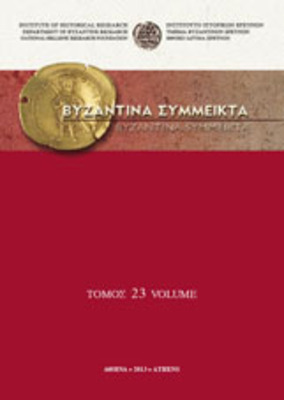Τὰ οἰκονομικὰ τῶν ἐπισκόπων στίς πρῶτες δεκαετίες τοῦ 16ου αἰώνα καὶ ἡ περίπτωση τοῦ Γενναδίου Σερρῶν
Part of : Βυζαντινά Σύμμεικτα ; Vol.12, No.1998, pages 271-317
Issue:
Pages:
271-317
Section Title:
Ιστορική έρευνα
Author:
Abstract:
Criton ChryssochoidisThe Financial Situation of Bishops in the First Decades of the 16th Century and the Case of Gennadius of Serres In the first part of this study evidence about the personality and the activities of Gennadius, metropolitan of Serres, is examined. An important feature of his long rule (1509-1540) is the donations he granted to monasteries, namely the Great Lavra in Mount Athos, as well as to the metropolis of Serres. As far as the Great Lavra is concerned, Gennadius financed the restoration and the wall paintings of the trapeza. He also offered precious objects, manuscripts and bought adelphata. Gennadius made also generous donations to the metropolis of Serres, to the adjacent monastery of Prodromos and the monastery of Kossinitza. The 16th century is generally considered as a period of financial difficulty for the Christian population of the Ottoman Empire. The presence of a wealthy bishop is examined in the second part of the present study within this framework. In particular, we focus on the development of the financial situation of a metropolitan as it emerges through the synodic acts of election and ordination of the prelates and of berats, with which the election was acknowledged by the Ottoman authorities and the actual appointment took place. In the Greek documents of the second half of the 15th century references to the financial state of hierarchs are vague and general. On the contrary, in the 16th century, and especially after the synodic act of 1497, which among other things regulated issues regarding the income of bishops and the way of its collection, we encounter more detailed information that enable us to acquire a clearer picture. Ottoman berats present a similar picture. Combining this evidence with that deriving from other sources we may draw conclusions about the institutionalised income of metropolitans in the first decades of the 16th century: kanonikon, marriage rates, income from ecclesiastical fairs (panegyris), sources of holy water (hagiasma), zeteia, heritage of priests and monks, other usual sources (ta synethe) of income (emvatikion, exagoreutikion), income from properties owned by the metropolis as well as income from subordinate bishops. Finally, we conclude that this income together with the stable state of the currency, especially during the first half of the 16th century, and the political stability of the Ottoman state contributed to the development of bishops' finances, to the accumulation of wealth and of a surplus, that could thus be used for donations, an activity widespread among the bishops at the 16th century.
Subject:
Subject (LC):
Keywords:
Γεννάδιος Σερρών, Σέρρες, Μονή Μεγίστης Λαύρας Αγίου Όρους, Επισκοπικά έσοδα, Κανονικόν, Κανονικόν των μονών, Γαμικά συνοικέσια, Πανηγύρεις, Αγιάσματα, Ζητεία, Κληρονομίες ιερέων, Κληρονομίες μοναχών, Εμβατίκιον, Εξαγορευτικόν, Έσοδα ακίνητης περιουσίας, Οθωμανική αυτοκρατορία, 16ος αι., Έγγραφα
Notes:
Αιώνες: 16ος - 16ος
Electronic Resources:




